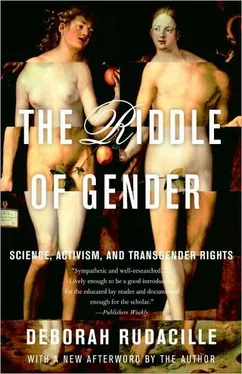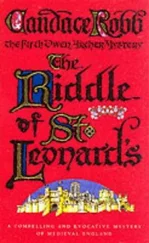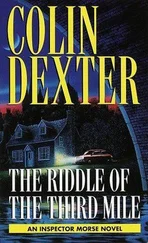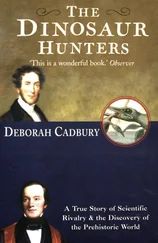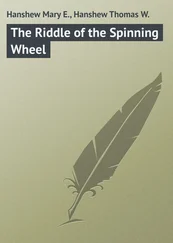My research trip and my freedom to define myself as a woman in any way I choose are in many ways the consequence of a social revolution that began around the time Hirschfeld was initiating his research, when a “New Woman” appeared to challenge prevailing beliefs about the essential nature of the sexes. “The nineteenth century had cherished a belief in the separate spheres of femininity and masculinity that amounted almost to a religious faith,” comments the distinguished literary scholar Elaine Showalter in Sexual Anarchy, a study of the fin de siecle and that era’s revolutionary retooling of sex. This faith was founded, Professor Showalter and other scholars point out, on the icon of the “womanly woman,” the flower of femininity. The womanly woman was first and foremost a mother and a wife. She was gentle and soft and self-sacrificing. Her natural place was the home, which she sought to make a place of comfort and beauty. “Often compared to a flower, a kitten, or a child, she was modest and pure-minded, unselfish and meek. She knew her place well; naturally fitted to the common round of household duties, she could make a home of a hovel by ministering to the needs of her husband, either as uncomplaining drudge or angel on the hearth. Nothing in herself, the littlest and least of all creation, she achieved greatness not in her own right but in her relat-edness as daughter and wife,” writes historian Patricia Marks. “The ‘womanly woman’ was one of the nineteenth century’s most memorable myths.”
The New Woman, who appeared as if by magic on two continents, Europe and North America, late in the nineteenth century, was an iconoclastic figure who blasphemed this gospel of femininity. She rejected the cult of maternity and self-sacrifice conceived as elements of the essential nature of womanhood. She argued for self-determination and self-fulfillment. She was not exactly a feminist, as her primary goal was not to gain legal or political rights. The defining characteristic trait of the New Woman was her desire to live life on her own terms and her refusal to be defined solely as daughter, wife, or mother. With her masculine thirst for education and work, lack of interest in marriage and motherhood, and demands to be taken seriously as a human being, the New Woman raised disturbing questions about the essential natures of men and women.
In the 1880s, women in England and France were finally granted the right to divorce unfaithful spouses and own property in their own right. Women’s colleges were founded in the United States and England, and in France secular secondary public-school and university education was opened to both sexes. Demographic changes also sent large numbers of women into the workforce, with or without an education. When the 1891 British census revealed that there were approximately nine hundred thousand more females than males in the total population, there was a great deal of public hand-wringing about the eventual fate of such “surplus” women, who might never marry or have children. Instead, they became the first generation of Western women to move to urban areas alone to work as shopgirls, teachers, journalists, and secretaries.
These New Women rejected sexual apartheid in word and deed; the visible emblem of their revolt was their mode of dress. Throwing off corsets, bustles, and back-buttoned bodices, the New Woman advocated “rational dress,” suitable for work, shopping, and exercise. Her divided skirts permitted free movement but were attacked by conservatives as an attempt to usurp the powers and privileges of men. Trousers or “bifurcated garments” defined masculinity, in the same way that restrictive corsets and crinolines defined femininity, and conservatives were determined to enforce not only the inner dichotomy between the sexes but also their external manifestation. The New Woman was in fact a “cross-dresser” of sorts, and she was both mocked and slandered for daring to wear masculine garments. An article in the British medical journal The Lancet declared the wearing of trousers “detrimental to the health and morals” of women. New Women were accused at various times, by various commentators, of being sexually promiscuous, sexually neutered, or lesbians—accusations that were to reappear in the middle of the twentieth century, when second-wave feminists once again began challenging social norms of femininity.
The New Woman of the fin de siecle was often coupled in print with a similarly transgressive male figure—the dandy, or aesthete, epitomized by Oscar Wilde and other decadent artists and writers. Languorous men devoted to the “poetry of appearance,” with an intense interest in fashion and interior decoration, dandies were not a new phenomenon, but in the context of late-nineteenth-century industrialization, they were newly disturbing. Wilde was gay, but many other dandies were heterosexual men, the forefathers of today’s “metrosex-ual.” With their attention to style and their embrace of elegance, extravagance, and artificiality, they expressed values coded “feminine” in the nineteenth century. In rejecting a focused professional life for an aesthetic dilettantism, the dandy expressed values once labeled aristocratic—but in the muscular new world of capitalist commerce, such languour appeared unacceptably feminine. The foppish masculinity of the dandies and decadents and their refusal to be “men,” as that term was commonly understood, were just as much a threat to the established order as the steely femininity of the New Woman. This challenge to conventional sex roles went deeper than mere fashion, as conservatives understood very well. Fin de siecle sexual anarchy was the first modern Western assault on patriarchy, and its scouts were New Women, dandies, and “an avant-garde of male artists, sexual radicals and intellectuals who challenged its class structures and roles, its system of inheritance and primogeniture, its compulsory heterosexu-ality and marriage and its cultural authority,” says Showalter.
Hirschfeld himself seems to inhabit a kind of borderline between traditional and modern views of masculinity and femininity. Asserting that “absolute” men or women who adhered perfectly in all respects to the traditional attributes of their sex as commonly defined were only “abstractions, invented extremes,” Hirschfeld nonetheless appears to have shared the traditional view that women were by nature less suited to intellectual work than men, for example. Although he formed political alliances with feminists, he was far from being a feminist himself, as we would define the term today. Masculinity and femininity appear in Hirschfeld’s theory of intermediaries as something akin to Platonic ideals, rather than social roles; the masculine and feminine ideals and their varying expression are, in his view, firmly anchored in biology. “In each person there is a different mixture of manly and womanly substances, and as we cannot find two leaves alike on a tree, then it is highly unlikely that we will find two humans whose manly and womanly characteristics exactly match in kind and number,” Hirschfeld writes.
This organic theory of gender variance led naturally for Hirschfeld to an acceptance of human sexual diversity, including a new tolerance for homosexuality, which was viewed then (as it still is in some quarters today) as the most extreme example of sexual “inversion.” “In a radical departure from earlier medical practices, Hirschfeld developed a psychotherapeutic procedure that emphasized the client’s ability to accept his own homosexuality, rather than to change it,” writes neuro-scientist and author Simon LeVay, who analyzed Hirschfeld’s research in his book Queer Science. Hirschfeld and his colleagues at the institute focused on helping their clients develop “strategies for surviving in a world that was still hostile to homosexuals,” writes LeVay. Hirschfeld’s approach to cross-dressers was equally progressive. He provided letters to the Berlin police, asking that his patients be allowed to dress in the clothes they felt most appropriate, for medical reasons. In many cases, the request was granted.
Читать дальше
